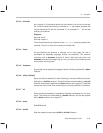
Assembler
5-36
Example:
#IF expression
; do something here
#ELSE
; do other things here
#ENDIF
#IFDEF symbol: Start of a conditional assembly structure. If symbol has been
defined (either with a #DEFINE directive or an EQU directive) then the lines
following this directive are assembled until a #ELSE or a #ENDIF directive are
encountered. If symbol has not been defined, then all input lines are skipped
until a #ELSE or a #ENDIF directive is encountered. If a #ELSE directive is
encountered first, all lines following it are assembled, until a #ENDIF directive
is found.
#IFNDEF: Start of a conditional assembly structure. If symbol has NOT been
defined then the lines following this directive are assembled until a #ELSE or
a #ENDIF directive are encountered. If symbol has been defined (either with
a #DEFINE directive or an EQU directive), then all input lines are skipped until
a #ELSE or a #ENDIF directive are encountered. If a #ELSE directive is
encountered first, all lines following it are assembled, until a #ENDIF directive
is found.
Example:
#IFDEF symbol
; do something here
#ELSE
; do other things here
#ENDIF
#IFNDEF symbol
; do something here
#ELSE
; do other things here
#ENDIF
#START_FT: This directive is created by the C– – compiler when it outputs
assembly code to a file. It marks the beginning of the
function table
used to
track function calls and C– – variables in the emulator.
Users should NEVER
use this directive in an assembly language program.
AORG expression: Marks the start of an ABSOLUTE segment code, i.e., a
segment that cannot be relocated by the linker.
expression
evaluates to the
starting address of the absolute segment in the program memory.


















